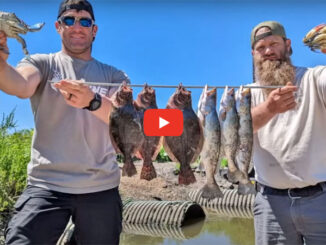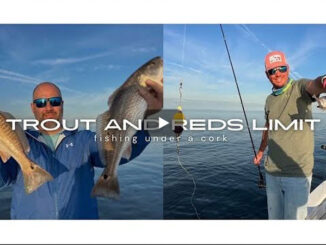The floating stick bait looks humble compared to the menagerie of other gadgets also called topwater lures, which feature all manner of bling like propellers, wings, twirling bodies, fur, tails, and giant mouths, to name a few. Why do we bother fishing such a seemingly simple lure like the floating stick bait?
Firstly, there is much fish-attracting action available from a floating stick bait despite its simple appearance. From the underwater perspective of a trout or redfish, a stick bait being walked across the surface looks and sounds like a darting bait fish. In my mind, a darting bait fish is either injured or being chased, and that means it’s vulnerable to attack from below. That seems to also be the view of gator trout, which are often caught on floating stick baits.
Second, let me walk back the notion that floating stick baits are simple lures which the designers probably whipped up during a Super Bowl commercial. These lures are carefully shaped to produce a particular walking action and a sound tuned to the designer’s liking. That seemingly simple shape differs across the various models in subtle ways such as length to diameter ratio, cross sectional roundness, nose taper, bottom rocker, and so on.
Many of the models have unique sounds like the low frequency thump of a Heddon Spook One Knocker, the harsh clatter of a MirroLure She Dog, or the chorus of high frequency pops like the Matrix Shad Matrix Mullet. Trout respond differently to action and sound across the range of daily conditions and seasons, so fishing in all conditions with just one floating stick bait is as productive as picking satsumas only from one side of the tree.
Springtime is the right time
For a number of reasons, spring is the best time of the year to throw floating stick baits for speckled trout. First, these baits are best suited for shallow water lakes and flats and speckled trout are plentiful in such areas in the spring. Secondly, in Louisiana, common forage species like the brown shrimp and croakers are small in April and it takes a lot of them to fill a trout’s stomach. But there are larger fin fish species like mullet and pogies in the marsh, which make bigger meals for trout and are easily patterned by a skilled angler working a stick bait. Thirdly, pretty much everyone wants to catch larger speckled trout if possible and floating stick baits really ring the dinner bell for gator trout. If you forget everything else, remember this, gator trout are present in shallow water in the spring, they want to eat large fin fish, and they will try to absolutely destroy a walking stick bait.
I work floating stick baits either with a walk-pause cadence or a medium to fast continuous walk. I personally don’t walk the stick baits slowly, but if you have found that to be effective, good deal. Most of these baits are from 1/2-ounce to 1-ounce, so you can cast them very far and you should. Most likely you will be fishing large, shallow areas, so long casts are the most efficient way to work these areas. A bright sun overhead is typically not stick bait friendly, so cloudy days, and morning and evening are the best times for floating stick baits.
Forget about walking the dog this spring, and go walk a stick bait!


